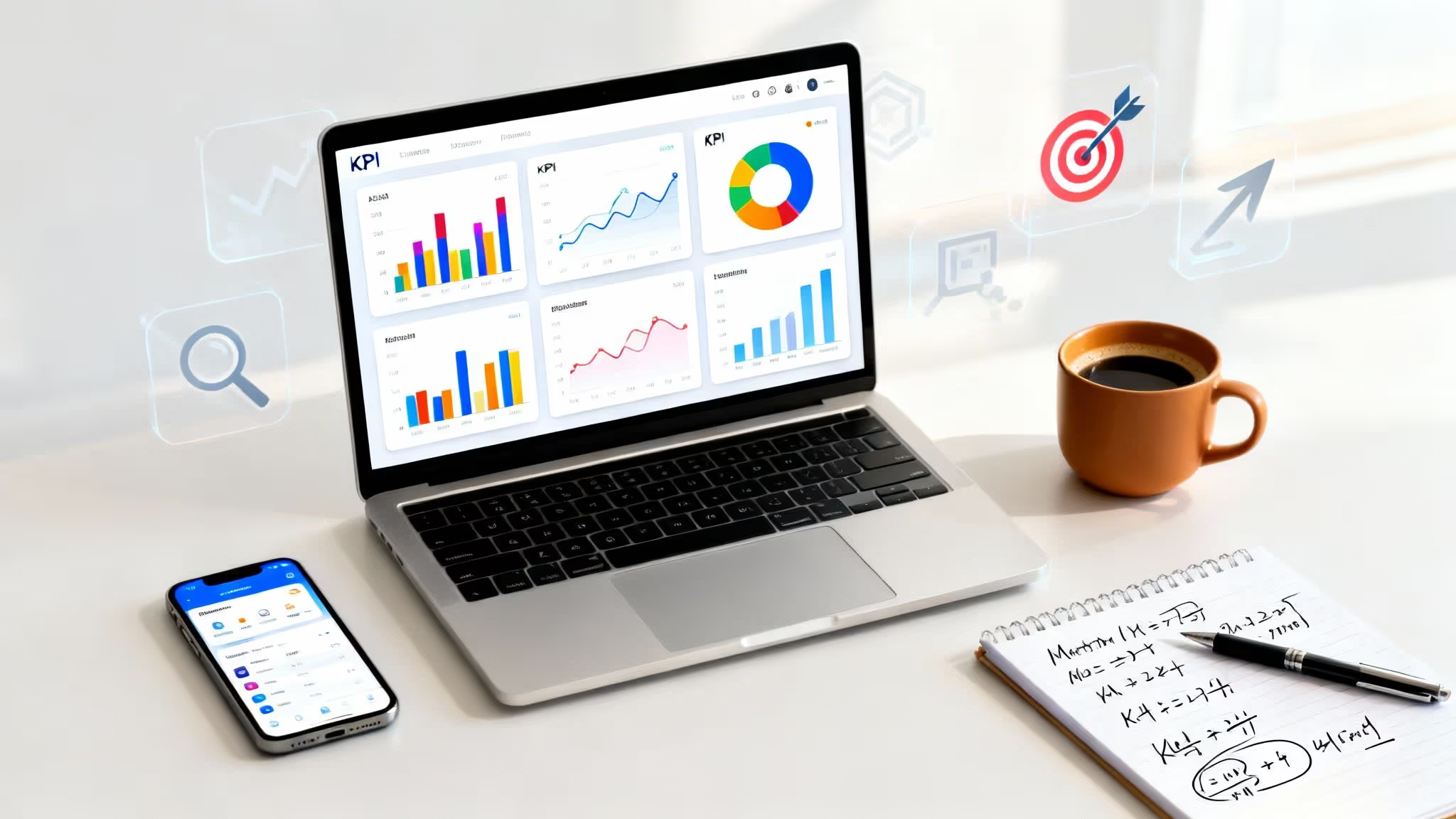Before you can improve brand awareness, you must get the fundamentals right. This means defining a crystal-clear brand identity, truly understanding your audience, and setting measurable goals. It's a strategic process that transforms your brand from a mere name into a meaningful connection built on trust and recognition.
Defining Your Brand for a Real Connection

Before spending a single dollar on a campaign, the real work begins internally. You must codify what your brand is, what it promises, and why anyone should care. This isn't just about a clever logo or a snappy tagline; it’s about locking in the core essence that will guide every marketing decision.
Without this clarity, efforts to build awareness become a scattered mess of disjointed tactics, wasting time and money. A strong brand identity is your North Star, ensuring every piece of content, social media post, and customer interaction feels authentic and cohesive.
Crafting a Powerful Brand Mission and Voice
Your brand mission is your "why"—a simple, powerful statement explaining your purpose beyond profit. When crafted correctly, it resonates with both your team and your audience, giving them something to rally behind.
Consider Patagonia's mission: "We're in business to save our home planet." This single sentence dictates everything they do, from their products to their activism. It forges an unbreakable bond with customers who share those values.
Once your mission is set, define your brand voice. This is the personality your brand projects. Are you an authoritative expert or a witty, informal friend? Whatever you choose, maintain consistency everywhere, from website copy to email newsletters.
Key Takeaway: A well-defined mission and voice aren't just for an internal style guide. They build an emotional bridge to your audience, making your brand more memorable and relatable.
Establishing a Memorable Visual Identity
While a brand is more than its looks, a strong visual identity is non-negotiable for recognition. The data supports this: consistent brand presentation can increase revenue by 33%. This consistency creates a mental shortcut for consumers, helping them spot your brand instantly in a crowded marketplace.
Your visual identity consists of several key components:
- Logo: The cornerstone symbol of your brand.
- Color Palette: A specific set of colors chosen to evoke the right emotions.
- Typography: The fonts used across all your materials.
- Imagery Style: The specific aesthetic of photos, illustrations, and graphics that represent your brand.
These elements must work in harmony. A luxury brand might use a minimalist logo, a sophisticated black-and-gold palette, and elegant serif fonts. In contrast, a tech startup would likely opt for a bold, modern logo and a vibrant color scheme to communicate innovation. Our complete guide on branding and visibility delves deeper into making these elements work together.
Setting Tangible Brand Awareness Goals
To improve brand awareness, you must set trackable goals. Vague ambitions like "get our name out there" are ineffective because they're immeasurable. Instead, focus on specific key performance indicators (KPIs) that demonstrate progress.
This is where building trust and recognition translates into tangible business value. A recent survey found that 81% of consumers need to trust a brand before buying from it. And since people are 50% more likely to purchase from brands they recognize, building familiarity is directly tied to your bottom line.
Start by benchmarking your current position, then set realistic targets for improvement. Your goals could include:
- Increase direct website traffic by 20% in six months.
- Grow social media mentions by 30% over the next quarter.
- Boost branded search query volume by 15%.
Setting these tangible benchmarks creates a framework for measuring success and proving the ROI of your brand-building efforts. This data-driven approach transforms brand awareness from a fuzzy concept into a measurable business objective.
Creating Content That Builds Authority
Once your brand's foundation is solid, content is what puts it to work. Think of it as tangible proof of your expertise—it's how you converse with your audience and build a relationship long before a purchase. Great content isn't about volume; it's about delivering real, tangible value that solves problems.
Consistent, high-value content shifts your brand from being another company selling something to a trusted advisor. People begin to see you as the go-to resource. That's how you earn trust and stay top-of-mind, winning them over before a sales pitch is ever made.
Choosing Formats That Actually Resonate
Not all content is created equal. The right format can make or break its effectiveness because you must meet your audience where they are. Some people prefer diving into a detailed blog post, while others would rather watch a quick, engaging video.
A smart content strategy typically includes a mix of formats, each playing a specific role.
- In-Depth Blog Posts and Guides: These are your authority-builders, perfect for tackling complex topics and capturing valuable search traffic.
- Engaging Videos: Whether it's a short clip for social media or a detailed tutorial for YouTube, video is incredibly powerful for storytelling and showing your brand’s human side.
- Case Studies and Success Stories: Nothing builds confidence like showing real results. Case studies offer concrete proof that you can solve your customers' problems.
- Interactive Tools: Calculators, quizzes, or assessment tools provide immediate, practical value, making them incredibly shareable and memorable.
Before creating content, your brand's visual and tonal consistency must be locked down. This foundation ensures everything you produce is cohesive.

Following this process ensures that every blog post, video, or tool reinforces the same core identity. That’s how you build recognition and make your brand stick.
To help prioritize, map content formats directly to your brand awareness goals.
Matching Content Formats to Brand Awareness Goals
Using a table like this helps you move from simply creating content to strategically deploying it for maximum brand impact.
Putting a Practical Content Calendar in Place
An idea remains just an idea until scheduled. A content calendar turns ambitious plans into a manageable workflow. It's your roadmap for organizing topics, assigning tasks, and—most importantly—ensuring a consistent flow of value to your audience.
Without a calendar, it's easy to fall into a reactive, sporadic posting pattern, leading to gaps and missed opportunities. A simple plan helps align your content with marketing campaigns, seasonal events, and business goals, making every piece work harder for you.
Expert Tip: Stop thinking in one-off articles and start planning in "topic clusters." Create a major "pillar" piece on a broad subject, then surround it with smaller "cluster" posts that dive into specific subtopics. This strategy is a powerhouse for SEO and immediately positions you as an expert.
Building SEO in from the Start
For your content to build awareness, people must find it. This is why search engine optimization (SEO) can’t be an afterthought—it must be baked into your creation process from day one.
It all begins with keyword research. You need to understand the exact words and phrases your audience uses on Google. Tools like Ahrefs or SEMRush are invaluable for uncovering these high-intent search queries to build your content around.
Once you have your target keywords, weave them naturally into your content in key places:
- Title and Headings: These are the most important signals to both users and search engines about your content's topic.
- Body Content: Use your main keyword and related terms contextually. This isn't about stuffing; it's about demonstrating expertise.
- Meta Description: Write a compelling summary that encourages clicks from the search results page.
- Image Alt Text: This improves accessibility and gives search engines another clue about your content's focus.
An SEO-first approach isn't about tricking algorithms. It's about creating genuinely helpful, high-quality content that is intentionally structured to be discovered by the people who need it most.
Amplify Your Reach Across the Right Digital Channels

Creating killer content is a huge win, but it’s only half the battle. The most insightful article is worthless if no one reads it. A smart distribution strategy is the engine that turns your message from a whisper into a roar, reaching far beyond your immediate followers.
This isn’t about blasting your content everywhere and hoping something sticks. It’s a calculated game of showing up where your ideal customers already are. A multi-channel approach is key to getting noticed in a crowded market.
Master Social Media with Real Authenticity
For many, social media will be their first encounter with your brand. Simply having a profile and posting occasionally won't cut it. The real magic happens when you build a genuine presence on the right platforms—the ones your audience actually uses.
Don't stretch yourself thin. A B2B tech firm will likely gain massive traction on LinkedIn with deep industry insights, while a lifestyle brand can build a passionate following on Instagram or TikTok with compelling visuals. The goal is to go deep on a few channels, not shallow on many.
Once you’ve picked your platforms, create content that feels native to them. A formal case study will fall flat on TikTok, but a snappy 30-second video breaking down the key takeaway could go viral.
Tap into New Audiences with Guest Blogging
One of the fastest ways to build authority and reach a fresh, relevant audience is through guest blogging. When you contribute a genuinely helpful article to an established publication in your niche, you "borrow" their audience and hard-won credibility.
This isn't just a vanity play; it’s a powerful SEO move. A solid guest post almost always includes a valuable backlink from a reputable site. That's a huge signal to Google that your website is a credible source, boosting your organic search rankings over time.
To succeed, prioritize quality over quantity:
- Target the Right Publications: Pinpoint the blogs your ideal customers read and trust.
- Pitch Unique, High-Value Ideas: Propose a specific article idea that fills a genuine gap in their content.
- Bring Your A-Game: Write something truly insightful. Your goal is to impress their readers so they're compelled to visit your site.
Build Lasting Relationships with Email Marketing
Social media is for the first handshake; email is where you build the long-term relationship. Your email list is a direct line to people who have explicitly asked to hear from you. It's a channel you completely own.
Use your newsletter for more than just announcements. Share exclusive insights, behind-the-scenes stories, or special resources for subscribers. This approach keeps your brand top-of-mind and builds a loyal community.
Key Insight: Treat your email list like a VIP club, not a megaphone. Consistently delivering value straight to their inbox turns casual followers into your biggest fans—the people most likely to share your work and become customers.
Forge Strategic Partnerships and Collaborations
You don't have to grow your audience alone. The right partnership or influencer collaboration can introduce your brand to a massive, targeted audience almost overnight. The trick is finding partners whose audience and values align with your own.
This could involve co-hosting a webinar, sponsoring a niche podcast, or working with a respected influencer. When evaluating potential partners, don't just focus on follower counts.
Ask yourself these questions:
- Audience Alignment: Do their followers fit your ideal customer profile?
- Brand Values: Are their mission and tone in sync with yours?
- Engagement: Do people genuinely interact with their content?
- Authenticity: Would a collaboration feel natural or forced?
A great partnership is a win-win-win. You get exposure and credibility, your partner provides value to their audience, and the audience discovers a great new resource. This third-party validation is one of the most powerful ways to build trust and accelerate brand awareness.
Using Technology to Jumpstart Brand Growth
In a market where attention is everything, technology is your biggest advantage for building brand awareness. This goes beyond having a website; it’s about using modern tools to create memorable customer experiences.
The brands breaking through today weave technology into everything they do, turning everyday interactions into something special. This is about more than buying the latest software; it's a fundamental shift in how you connect with your audience. By using tech to understand customer needs, personalize your messaging, and create unique touchpoints, you can generate serious buzz and stand out.
Start With Data to Truly Understand Your Audience
Before you can tailor any experience, you must know who you're talking to. Data analytics tools are your secret weapon, offering a window into your customers' minds. I'm not talking about basic demographics.
Modern analytics platforms, like Google Analytics or more advanced tools like Mixpanel, reveal how people interact with your brand at every step. You can see which blog posts they read, what product features they use, and where they drop off. This behavioral data is pure gold, helping you understand their real problems and motivations. Armed with that knowledge, you can create hyper-relevant experiences that make your audience feel understood.
Imagine a B2B software company notices that a specific user group consistently reads articles about a single problem. That’s a signal to create a targeted webinar or an in-depth guide that tackles that exact challenge. This data-driven approach ensures your efforts are focused and effective.
The most impactful brands don't just sell products—they solve problems. When you use data to identify your audience's true needs, you can position your brand as an essential partner, building lasting loyalty.
Personalize Everything—But at Scale
With rich data, you can move beyond generic marketing. The goal is to deliver the right message to the right person at the right moment, making it feel like a one-on-one conversation, even at scale.
Here are a few ways to achieve this:
- Dynamic Website Content: Show a different homepage banner to a visitor from the finance industry versus one from healthcare.
- Personalized Email Journeys: If someone downloads an ebook, trigger an automated email series offering more content on that specific topic.
- Smarter Retargeting Ads: Serve ads for a specific product only to people who have already viewed that product page.
The key is to be helpful, not creepy. When done right, this level of personalization makes your brand feel incredibly relevant and valuable, cementing its place in your customer's mind.
Think Like a Tech Company (Even if You’re Not)
Market leaders don't just use available technology; they find new and creative ways to engage their audience. The brands seeing exponential growth are almost always seen as pioneers. Just look at the world’s most valuable brands.
A recent report shows the total value of the top 100 global brands has climbed to $10.7 trillion, a figure largely driven by tech-first companies. Apple maintained its top spot with a $1.3 trillion valuation, and tech-centric companies like Nvidia saw their brand value explode by over 100%. New players like ChatGPT demonstrate that a disruptive, tech-forward idea can build global awareness with incredible speed. You can explore the complete findings in the Kantar BrandZ Global Top 100 report.
This doesn't mean your business needs to invent the next big thing. It’s about being open to innovation. Maybe you’re the first in your industry to create an interactive cost calculator, or you use AR to help customers visualize your product in their space.
These novel interactions get people talking, create shareable moments, and position your brand as a forward-thinking leader. That’s how you stop just competing in the market and start shaping it.
Measuring Your Brand Awareness Impact

You’ve done the work, defined your goals, and crafted your message. How do you know if any of it is working?
Pouring resources into brand awareness without tracking results is just guesswork. To make smart decisions and prove value, you need to get serious about measurement. This means looking beyond vanity metrics and digging into data that shows people aren't just seeing your brand—they're remembering it.
Moving Beyond Vanity Metrics
It's tempting to get excited about a jump in page views or a few hundred new followers. While these numbers aren't meaningless, they don't paint the full picture. True impact is measured by signals that show genuine recognition and recall.
These are the core metrics to watch:
- Direct Traffic: When someone types your URL directly into their browser, it’s a clear sign your brand name is sticking. They sought you out intentionally. Find this data in Google Analytics under
Acquisition > Traffic acquisition. - Branded Search Volume: How many people are Googling your company name? An upward trend here is a fantastic indicator that awareness is growing. Track this using Google Search Console.
- Social Media Share of Voice: This metric measures how many people are talking about you online compared to your competitors. It's a powerful way to benchmark your standing in your niche.
Focusing on these three gives you a much more honest assessment of your brand's health and the ROI of your campaigns.
Essential Tools for Gathering Data
You can't track what you can't see. Thankfully, incredible tools are available to pull back the curtain and get the data you need.
Here are a few must-haves:
- Google Analytics: This is non-negotiable. It’s the foundation for understanding who is coming to your site and how they got there.
- Social Listening Platforms: Tools like Brand24 or Talkwalker are game-changers. They scan the web for mentions of your brand, helping you measure sentiment and share of voice.
- Brand Monitoring Software: Platforms like Ahrefs and SEMrush can find "unlinked mentions"—where your brand is discussed without a link—giving you a chance to see your reach and build new backlinks.
My Two Cents: Don't just collect data—create a simple dashboard. Whether it's a spreadsheet or a dedicated reporting tool, having your key metrics in one place turns measurement from a chore into a routine, allowing you to spot trends and make data-informed decisions quickly.
Turning Insights into Actionable Strategy
Data is useless if it just sits in a report. The real magic happens when you use these insights to fine-tune your strategy, connecting your actions to the results.
Did you see a spike in branded search volume after a podcast guest appearance? That's a clear signal to pursue more podcasts. Is your share of voice flat on Twitter but growing on LinkedIn? It might be time to shift your content focus.
This cycle of measuring, analyzing, and refining separates good marketing from great marketing. It creates a continuous feedback loop that ensures your strategy is always evolving. Over time, this approach doesn't just build brand awareness; it builds the loyalty that is critical for increasing customer lifetime value.
Common Questions About Building Brand Awareness
When diving into a brand awareness strategy, a few key questions always come up. Getting clear on these from the start helps set realistic expectations with your team and stakeholders.
Let's tackle some of the most common questions from marketers and business owners.
How Long Until We Actually See Results?
This is the big one. While there's no magic number, you can usually start to see early positive signals within 3 to 6 months of consistent effort. These are leading indicators—like an uptick in direct website traffic, more social media chatter, or a rise in branded searches.
However, a major, measurable shift in market-wide recognition is a marathon, not a sprint. You’re typically looking at 12 to 18 months of dedicated, steady effort to achieve that deep-rooted awareness. Treat this as a long-term investment, not a quick campaign.
You're not aiming for a temporary traffic spike. The real goal is to build a lasting presence that becomes one of your company's most valuable assets. Patience is essential.
What’s the Real Difference Between Brand Awareness and Lead Gen?
It's easy to blur the lines, but brand awareness and lead generation are different—though deeply connected—goals that operate at different points in the customer journey.
Brand Awareness is top-of-funnel. The goal is simple: ensure your ideal customers know you exist. You want them to become familiar with your name, what you stand for, and the problems you solve. This is measured with metrics like reach, impressions, and brand recall.
Lead Generation is further down the funnel. This is where you turn initial awareness into active interest. The objective is to capture a potential customer's information, such as through a guide download or webinar signup. Success is measured in conversion rates and cost per lead.
Think of it this way: strong brand awareness makes lead generation easier and more cost-effective. When people already know and trust you, they're much more likely to provide their contact information. One feeds the other, creating a healthier marketing engine.
Can a Small Business Really Compete With the Big Guys?
Yes, absolutely. Being a smaller business can be a huge advantage. You can be more agile, personal, and authentic than a massive corporation. You might not have the budget for a Super Bowl ad, but you can outmaneuver competitors by being smarter and more focused.
Instead of trying to be everywhere, pour your energy into a few key areas:
- Dominate a Niche: Find a specific corner of the market and become the go-to expert. Create incredibly helpful content that speaks directly to that audience's unique challenges.
- Build a Real Community: Don't just post on social media—engage. Pick one or two platforms where your customers hang out and build genuine relationships through real conversations.
- Master Local SEO: If you have a local presence, optimizing your Google Business Profile and local search terms can make you the obvious choice for customers in your area.
- Encourage Customer Stories: Get your happy customers to share their experiences. A recommendation from a real person is often more powerful and trustworthy than any ad.
By being strategic, a small business can build a fiercely loyal following and grow its brand awareness without a massive budget.
Ready to move beyond guesswork and build a brand that drives real business growth? At Twelverays, we specialize in data-driven digital marketing strategies that deliver measurable results. Let's create a tailored plan to elevate your visibility and connect with the customers who matter most. Learn more about our approach.





